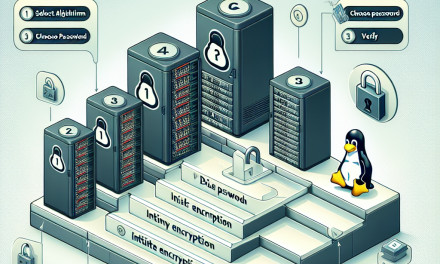In today’s digital landscape, safeguarding your data has never been more crucial. With the rise of cyber threats and increased data privacy regulations, organizations must take proactive measures to protect sensitive information. One of the most effective ways to secure data in Linux environments is through the use of ZFS (Zettabyte File System) and its built-in encryption features. This article serves as a comprehensive guide for implementing encryption on ZFS pools, ensuring your data remains protected against unauthorized access.
Understanding ZFS Encryption
ZFS, originally developed by Sun Microsystems, has become a preferred file system in Linux-based environments for its advanced features, including snapshots, replication, and data integrity checks. One of the notable advantages of ZFS is its support for encryption. With ZFS encryption, data is automatically encrypted before being written to disk, ensuring that sensitive information is protected even if the physical drives are compromised.
Key Features of ZFS Encryption
- Transparent Encryption: ZFS encryption is transparent to applications. Once configured, data is encrypted and decrypted automatically, eliminating the need for manual intervention.
- Dataset-Level Encryption: ZFS allows for the encryption of individual datasets rather than the entire pool, providing flexibility for applications with varying security requirements.
- Key Management: ZFS accommodates various key management strategies, enabling users to utilize their preferred method for key generation and management, including native key management or external solutions.
- Performance: The performance impact of ZFS encryption is minimal, owing to the use of efficient encryption algorithms and the inherent advantages of ZFS’s architecture.
Prerequisites
Before diving into the encryption process, ensure your Linux server meets the following requirements:
-
ZFS Installation: Verify that ZFS is installed on your Linux server. The exact installation steps may vary based on your Linux distribution. Common distributions include Ubuntu, CentOS, and Fedora.
bash
sudo apt install zfsutils-linux
sudo yum install zfs
-
Kernel Support: Ensure that your Linux kernel supports ZFS encryption, especially if you’re using features from newer versions of ZFS.
Configuring ZFS Encryption
Now that your environment is ready, follow these steps to create and manage encrypted ZFS pools and datasets.
Step 1: Creating an Encrypted ZFS Pool
-
Create the ZFS Pool:
You can create a new encrypted ZFS pool directly by using the-O(options) flag:bash
sudo zpool create -O encryption=on -O keyformat=passphrase -O keylocation=prompt my_encrypted_pool /dev/sdXReplace
my_encrypted_poolwith your desired pool name and/dev/sdXwith the disk you want to use. -
Enter a Passphrase:
As prompted, enter a strong passphrase used to encrypt the pool. This will be required whenever the pool is imported.
Step 2: Creating Encrypted Datasets
You can also create encrypted datasets within an existing pool. This enables you to customize the encryption settings for different datasets.
-
Create an Encrypted Dataset:
bash
sudo zfs create -o encryption=on -o keyformat=passphrase -o keylocation=prompt my_encrypted_pool/my_datasetAgain, replace
my_encrypted_pool/my_datasetwith your desired dataset name. -
Enter a Passphrase:
Provide a strong passphrase for the dataset. This can be different from the pool’s passphrase.
Step 3: Managing Encryption Keys
Once encryption is configured, managing the keys is vital for data recovery and pool accessibility.
-
Exporting Keys:
To export the encryption key for a dataset:bash
sudo zfs key -e my_encrypted_pool/my_datasetThis command allows you to store the key securely externally.
-
Loading Keys:
If you need to execute a key load, you can do so with:bash
sudo zfs load-key my_encrypted_pool/my_dataset
Step 4: Accessing Your Encrypted Pools
When accessing an encrypted pool, you must provide the passphrase to unlock it. After a server restart or when importing the pool, authenticate using:
bash
sudo zpool import my_encrypted_pool
Followed by entering the passphrase when prompted.
Monitoring and Auditing
To maintain optimal security, regularly monitor your ZFS pools and datasets:
-
Check Pool Status:
bash
sudo zpool status -
View Dataset Properties:
bash
sudo zfs get all my_encrypted_pool/my_dataset -
Regular Audits: Implement a routine audit process for datasets and key management practices to ensure compliance with organizational data policies.
Conclusion
Implementing ZFS encryption on your Linux server provides a robust solution to safeguard your data from unauthorized access. This guide serves as a foundation for securing your ZFS pools, with detailed steps on creating, configuring, and managing encryption to protect sensitive information. By following best practices and maintaining regular monitoring and auditing, you can ensure that your ZFS-encrypted data remains secure in your organization.
For further inquiries or expert assistance regarding ZFS encryption, feel free to reach out to us at WafaTech! Your data’s security is our top priority.





